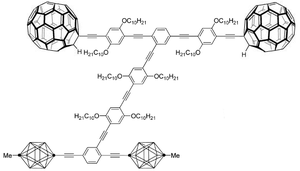- Nanodragster
-
The Nanodragster, dubbed the world's smallest hot rod, is a molecular nanocar.[1][2] The design improves on previous nanocar designs and is a step towards creating molecular machines. The name comes from the nanocar's resemblance to a dragster, as it has a shorter axle with smaller wheels in the front and a larger axle with larger wheels in the back.
Contents
Development
The nanocar was developed at Rice University’s Richard E. Smalley Institute Nanoscale Science and Technology by the team of James Tour, Kevin Kelly and other colleagues involved in its research.[3][4] The previous nanocar developed was 3 to 4 nanometers which was a little over a strand of DNA and was around 20,000 times thinner than a human hair.[5] These nanocars were built with carbon buckyballs for their four wheels, which made it need 400 °F (200 °C) to get it moving. On the other hand, a nanocar which utilized p-carborane wheels moves as if on ice.[6] Such observations led to the production of nanocars which had both wheel designs.
Specifications
The Nanodragster is 50,000 times thinner than a human hair and has a top speed of 0.014 millimeters per hour (0.0006 in/h).[2][7][8] The rear wheels are spherical fullerene molecules, or buckyballs, composed of sixty carbon atoms each, which are attracted to a dragstrip that is made up of a very fine layer of gold. This design also enabled Tour’s team to operate the device at lower temperatures.
Future use
The nanodragster and other nano-machines are designed for use in transporting items. The technology can be used in manufacturing computer circuits and electronic components, or in conjunction with pharmaceuticals inside the human body.[9] Tour also speculated that the knowledge gained from the nanocar research would help build efficient catalytic systems in the future.
See also
References
- ^ a b Vives, G. et al (2009). "Molecular Machinery: Synthesis of a Nanodragster". Org. Lett. 11: 5602. doi:10.1021/ol902312m. PMID 20000442.
- ^ a b Hadhazy, Adam (Jan. 19, 2010). "World's tiniest hot rod spurs nanotechnologies". MSNBC. http://www.msnbc.msn.com/id/34938564/ns/technology_and_science-science/. Retrieved 20 January 2010.
- ^ "Texas scientists develop 'nanodragster'". Nano Tech Now. http://www.nanotech-now.com/news.cgi?story_id=36312. Retrieved 2010-01-19.
- ^ Shirai, Y. et al. (2005). "Directional Control in Thermally Driven Single-Molecule Nanocars". Nano Lett. 5: 2330. doi:10.1021/nl051915k. PMID 16277478.
- ^ "Previous Nanocar Specifications". The Future of Things. http://www.tfot.info/content/view/102/61/. Retrieved 2010-01-20.
- ^ "World's Smallest Hot Rod Made Using Nanotechnology". http://www.livescience.com/technology/nano-dragster-100119.html.
- ^ "'Nanodragster' Races Toward the Future of Molecular Machines". Science Daily. http://www.sciencedaily.com/releases/2010/01/100106193320.htm. Retrieved 2010-01-19.
- ^ "'Nanodragster' races toward the future of molecular machines". Nano Techwire. http://www.nanotechwire.com/news.asp?nid=9244. Retrieved 2010-01-20.
- ^ "New Model Nanocar on the Showroom Floor". The Future of Things. http://www.tfot.info/content/view/102/61/. Retrieved 2010-01-20.
Categories:- Compact cars
- Nanotechnology
- Molecular machines
Wikimedia Foundation. 2010.

